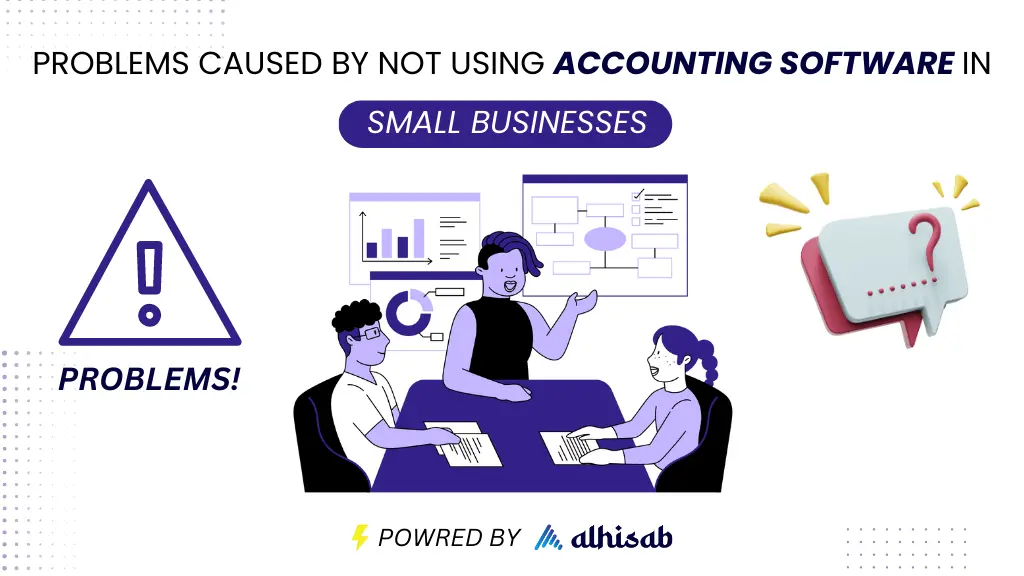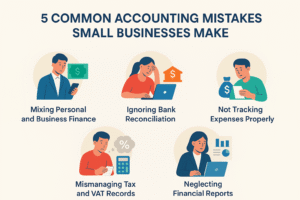1. Difficulty tracking income and expenses:
1.1. Manual data entry: Transactions must be manually entered into a spreadsheet or on paper without accounting software. This can take a lot of time and be error-prone.enses without accounting software can present several difficulties, including:
1.2. Difficulty in reconciling accounts: Account reconciliation can be challenging without accounting software since it can be more difficult to match transactions to credit card and bank statements, posing a risk to the accuracy of your records.
1.3. Limited ability to create financial statements: Producing financial statements like balance sheets and income statements without accounting software might be more challenging.
1.4. Difficulty in compliance with tax laws: With accounting software, it may be easier to ensure that your records comply with tax rules and regulations.
1.5 Inability to easily monitor progress over time: It might be challenging to compare your financial performance from one period to the next without accounting software.
1.6 Limited capacity to track multiple accounts: With accounting software, you can track one or two accounts at a time, making it more difficult to understand your financial condition fully.
2. Inefficient invoicing and billing in Accounting Software
2.1. Generate and send invoices: Creating and sending invoices to customers can be time-consuming and prone to errors.
2.2. Track payment status: With accounting software, it can be easier to track which invoices have been paid and which are still outstanding.
2.3. Send reminders for overdue payments: With accounting software, it can be easier to automate sending reminders to customers for overdue payments.
2.4. Analyze customer payment patterns: With accounting software, it can be easier to identify patterns in customer payment behavior, such as which customers are consistently late with payments.
2.5. Generate reports: With accounting software, generating reports such as a list of unpaid invoices or a summary of customer payment history can be easier.
2.6. Keep records of payments: Without accounting software, it can be harder to keep records of payments, which can be helpful for tax purposes,
3. Difficulty preparing and filing taxes
3.1. Difficulty in tracking deductions: With accounting software, it can be easier to keep track of deductions such as charitable donations, business expenses, and home office expenses.
3.2. Limited ability to generate tax forms: With accounting software, it can be easier to generate the forms and schedules required to file taxes, such as the 1040 or Schedule C.
3.3. Difficulty in organizing tax documents: With accounting software, it can be easier to organize tax documents such as W-2s, 1099s, and receipts in a way that makes it easy to find the information needed to file taxes.
3.4. Difficulty in analyzing tax data: With accounting software, it can be easier to analyze tax data, such as identifying deductions or credits that can be claimed.
3.5. Difficulty in ensuring compliance with tax laws: With accounting software, it can be easier to ensure that your tax filings comply with all relevant tax laws and regulations.
4. Limited financial reporting and analysis in Accounting Software
4.1. Difficulty in generating financial statements: With accounting softwares, it can be easier to generate financial statements such as income statements, balance sheets, and cash flow statements.
4.2. Difficulty in analyzing financial data: With accounting software, it can be easier to analyze financial data, such as identifying trends in revenue or expenses or comparing financial performance over time.
4.3. Difficulty in budgeting and forecasting: With accounting software, it can be easier to create and track budgets and make accurate financial forecasts.
4.4. Difficulty in identifying areas for cost savings: With accounting software, it can be easier to identify areas where a business can cut costs, such as identifying and eliminating unnecessary expenses.
4.5. Difficulty in compliance with accounting standards: Without accounting software, it can be harder to ensure that financial statements are prepared in compliance with accounting standards such as GAAP or IFRS
5. Difficulty managing payroll without accounting software
5.1. Difficulty in calculating payroll taxes and deductions: Without accounting software, it can be harder to calculate payroll taxes and deductions such as Social Security and Medicare taxes, federal and state income taxes, and other deductions such as employee 401k contributions.
5.2. Difficulty in tracking employee hours: With this software, it can be easier to track employee hours and calculate pay accordingly, especially for employees with varying or irregular schedules.
5.3. Difficulty in generating paychecks and direct deposit: With this software, it can be easier to generate employees’ paychecks and direct deposit information.
5.4. Difficulty in tracking vacation and sick time: It can be easier to track vacation and sick time for employees and ensure that pay is calculated correctly for employees who are out of work.
5.5. Difficulty in compliance with laws and regulations: With accounting software, it can be easier to ensure that the payroll complies with federal and state laws and regulations, such as minimum wage and worker’s compensation laws.
6. Difficulty in managing inventory and sales
6.1. Difficulty in tracking inventory levels: With accounting software, it can be easier to track inventory levels and ensure that stock is replenished on time to meet customer demand.
6.2. Difficulty in tracking sales: With accounting software, it can be easier to track sales, identify top-selling products, and analyze sales data to inform future business decisions.
6.3. Difficulty in generating invoices and purchase orders: With accounting software, it can be easier to generate invoices and purchase orders for customers and suppliers.
6.4. Difficulty in tracking customer information: With accounting software, it can be easier to track customer information, such as purchase history, contact information, and payment terms.
6.5. Difficulty in identifying areas for cost savings: With accounting software, it can be easier to identify areas where a business can cut costs, such as identifying and eliminating overstocked or slow-moving items.
7. Difficulty reconciling bank and credit card statements
Without accounting software, it can be not easy to reconcile bank and credit card statements and ensure that all transactions are recorded correctly.
8. Integration with other business software
With this software, it is easier to integrate with other business software, such as CRM or ERP systems, which can lead to inefficiencies in the overall business process.
It can help businesses manage their financial information by automating invoicing, tracking expenses, and generating financial reports. This can save time and reduce errors, allowing business owners to focus on other aspects of their business. Additionally, many accounting software programs can integrate with other business tools, such as point-of-sale systems and online payment platforms, making it easier to track all financial transactions in one place. This also helps to prevent fraud and embezzlement
- Alhisab: This software offers invoicing, expense tracking, and financial reporting, as well as integrations with other business tools.
- Zoho Books: This software includes features such as invoicing, expense tracking, and financial reporting, as well as inventory management and purchase order creation.
- Waves: This software is designed for small businesses and offers double-entry accounting, financial reporting, and budgeting features.
- KashFlow: This software is designed for small businesses; it offers invoicing, expense tracking, and financial reporting with a built-in CRM feature.
- NCH Express Accounts: This software is designed for small businesses; it offers invoicing, expense tracking, and financial reporting, with a built-in inventory management feature.



